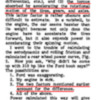I don’t know whether to THANK or curse Rocky!
My perception of Ron Graves’s incoherent approach to calculating the Power measured to accelerate an object first required me to review the definitions of Energy, Work and Power. It took awhile but at least I did recall the physics basics for solving such a problem without having to deal with differentials and integrals (I hated those things).
So in my mind, I derived the equations to allow the simple calculation of Power similar to Ron. This is where my real dilemma began! Even Ron mentioned his quandary since the calculation of power to get a 3300 pound object to 60 mph in 4 seconds was about the publish horsepower of an Escort. So for last couple days I had to find out why. I eventual found documentation and discussion with other engineer that explained it. Ron hinted upon it, but I don’t think he grasped the magnitude.
Unfortunately to determine an equation for rotational inertia power, some advance math is needed along with a lot of measurements and weights of the DRIVE TRAIN. As Ron implied the comparison of the horsepower measured on a dynamometer is basically at constant speed (or changing slowly) where in a real world drag strip measurement of performance, the power need to spool up all the drive train is significant. The “rule of thumb” used is nearly 40% horsepower is absorbed into spinning up the drive train. Once at a constant speed, that power can then be applied to the road.
So in Ron’s case, taken his measured accelerating 230 HP, assuming about 30% went into spooling up, gives an engine HP rating of over 300 HP thus agreeing with Ford’s published value.
So I will thank Rocky and Ron for making me learn something this week. For me, to learn something I have put my hands on it or in this case, get the math to add up.
PANTERA INTERNATIONAL
A DE TOMASO CAR CLUB
Presents the De Tomaso Forums
The On-Line Meeting Place for De Tomaso Owners and Enthusiasts From Around the World
Clicking on the banner will take you to the sponsor's website.


